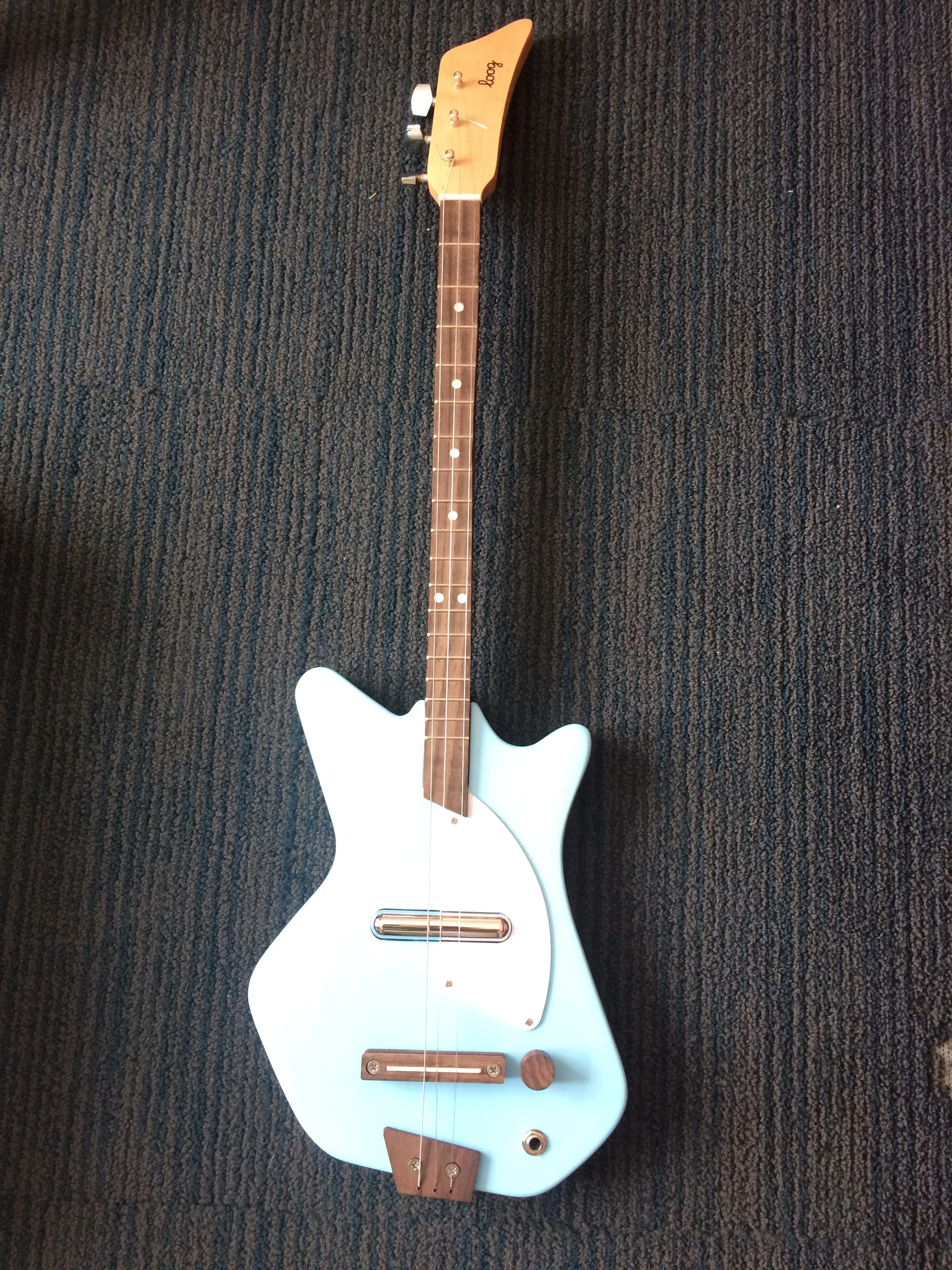We've been fans of Loog Guitars here at Zooglobble HQ from the beginning. I interviewed Rafael Atijas, the founder of the company, in 2011 as he was in the midst of his first (eventually successful) Kickstarter to manufacture his very first set of acoustic 3-string guitars. I dug that first guitar (it's the wooden one with a blue pickguard below), and so in 2013 when Atijas had his second Kickstarter to manufacture his first set of electric (again, 3-string) guitars, I interviewed him once more. That project succeeded, too -- raising $70,000, just a bit more than his first go-round. (You can also see that guitar, a blue one with a white pickguard, below.)
And really, if you can do an acoustic and an electric guitar well, why bother creating something new? Which is why you shouldn't listen to me for business advice, because something happened with his third Kickstarter. As successful as his first two were, that didn't come close to this one, as he raised almost $360,000 to manufacture 3 new guitars: the Loog Pro Acoustic and Loog Pro Electric, along with a new Loog Mini.
While the Loog Pro models looked nice, I basically already had those two guitars, albeit earlier versions of them. (Also, I'm not really a guitar player, so the Loog Pro would be wasted on me.) But the Loog Mini -- a 3-string guitar the basic size of a soprano ukulele -- that was definitely the most intriguing one to me. So I plunked down my $59 (they're $79 post-Kickstarter) and earlier this year it arrived at the home.
This Loog Mini is my new favorite Loog, and it's a close competitor for my Dan Zanes Flea Ukulele for the favorite stringed instrument (Non-Violin Division) in our household.
Unlike the first iteration of the Loog, these new guitars (as well as the earlier electric version) come pre-assembled. I'll admit to missing the opportunity to assemble the guitar with my son... for about 5 minutes. Because the 30-60 minutes spent previously assembling the guitar can now be spent diving right into making music.
If I had to pinpoint the difference -- for me, at least -- between this latest guitar and the previous iterations, it would be the level of just plain fun the new guitar engenders. No, our Boston Terriers do not know how to play them -- yet -- the decision to photobomb my pictures of the new Loog Mini seemed somehow appropriate for the playfulness of the instrument.
I am not a guitar person -- I grew up playing violin (and piano, and organ) -- and it's never really felt natural to me. Over time, the Loog has attempted a variety of ways to make it easier for a non-guitar-playing person to become a guitar-playing person. That includes different colors for the position markers to (theoretically) make it easier for a player to remember at what fret they should place their fingers for certain chords and video guitar lessons. I think their package now is particularly good -- they've dropped the colored position markers, but included two other things.
First, there's an app (available for iOS now, Android very soon). This is version 2.0 -- they had one before, which I never bothered with, but the new one features games, a tuner, and, one of the most important features, the ability to strum along with some popular songs. (This last one is accomplished by embedding YouTube videos, and superimposing chord names, and accessible only after the user strums those chords in advance.) For those of you wanting other lessons, those are still available through the app, featuring kindie's own Tim Kubart.
Second, the Loog Mini came packaged with a fun set of cards, slightly larger than a typical playing card, that illustrates 3 different chords for each note -- major, minor, and the seventh. I can't say that playing the F#-minor chord (as pictured above) will be a terribly common occurrence, but it's a more tangible way of seeing the chords (and doesn't require the use of your smartphone).
All of this would be meaningless, though, if it wasn't so easy to pick up and strum along. I know that it's fun for a kid to get out the electric guitar and the mini-amp and just play and play. But it can be a pain to get out everything necessary to play the electric guitar, whereas my son (Little Boy Blue) loves to play the Loog Mini. I think it's notable that the first time Little Boy Blue was interested in taking guitar lessons was after we got the Loog Mini. All he's doing is carving a little time out of his piano lesson for a guitar lesson (his teacher knows both), but the playfulness and easy action compared to the other guitars make it a great introduction to guitar.
For years, if somebody asked me what sort of instrument to get for a child, I'd recommend a ukulele over a guitar -- at the $50-$75 level the guitars were likely to be awful, while you can get a decent uke for that price. But now I feel like the only choice is whether the beginner (be it a child, or you yourself) wants to learn to play ukulele or guitar. If I had to choose, I'd probably still choose ukulele... but the point is, I never got to choose before. Now I can.
So, in sum, I'd highly recommend the Loog Mini to anyone (regardless of age) who's looking to get an instrument suitable for beginners. It's not a serious concert instrument, but in terms of quality it goes well beyond the concept of "toy instrument."











